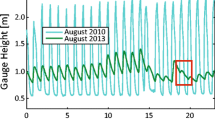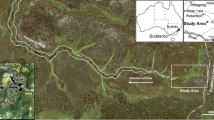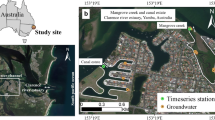Abstract
The vertical flux of water, ammonium, and phosphatewas measured from two developing barrier islandmarshes; Hog Island, VA (1.3 m tidal range) andPritchards Island, SC (2.5 m tidal range). Verticalflow and nutrient concentrations from the deposit weremeasured using seepage meters placed on the surface ofthe marsh. Measured water flow was not significantlydifferent between the sites (average = 60.1 and 57.4l m-2h-1for the VA and SC marsh). Verticalflow, calculated from piezometric head gradients andhydraulic conductivity, only accounted for 15 and 4%of measured flow at the VA and SC marshes,respectively. Horizontal flow, calculated as thedifference between measured total flow and calculatedvertical flow, was larger at the SC marsh. Therefore,tidal range seems to influence the direction(horizontal vs. vertical), but not the magnitude oftotal water flow from these developing marshes.Despite a lower tidal range, phosphate flux wassignificantly higher at the VA marsh (69 mmol m-2yr-1) relative to the SC marsh (11 mmol m-2yr-1) probably because of higher porewaterphosphate concentrations. Measured ammonium flux wasnot significantly different between the sites (194 and174 mmol m-2yr-1for the VA and SC marsh).Nutrient concentration must be considered togetherwith tidal range when assessing nutrient export. Thisstudy represents one of few that quantify nutrient andwater export from naturally-developing marshes.Although young marshes are thought to export smallquantities of nutrients and other materials, rates ofnutrient export from these developing marshes weresimilar to rates measured in older marshes. Therelatively high export rates from these developingmarshes were attributed to high rates of subsurfaceflow and high nutrient input from a buried marsh ormudflat located one meter below the present marshsurface. These results have implications fordevelopment of created or restored marshes especiallywhere the goals of those activities are to maximizewetland functions such as nutrient exchange.
Similar content being viewed by others
References
Bouwer, H. 1989. The Bouwer and Rice slug test - An update. Groundwater 27: 304–309.
Bradley, P.M. and Morris, J.T. 1990. Physical characteristics of salt marsh sediments: Ecological implications. Marine Ecology Progress Series 61: 245–252.
Broome, S.W., Seneca, E.D. and Woodhouse, W.W. Jr. Tidal salt marsh restoration. Aquatic Botany 32: 1–22.
Chambers, R.M. and Odum, W.E. 1990. Porewater oxidation, dissolved phosphate, and the iron curtain: Iron-phosphate relations in tidal freshwater marshes. Biogeochemistry 10: 37–52.
Chambers, R.M., Harvey, J.M. and Odum, W.E. 1992. Ammonium and phosphate dynamics in a Virginia salt marsh. Estuaries 15: 349–359.
Childers, D.L. 1994. Fifteen years of marsh flumes: A review of marsh-water column interactions in Southeastern USA estuaries. In: Mitsch, W.J. (ed.), Global Wetlands: Old World and New. pp. 277–293. Elsevier Science, New York.
Craft, C.B., Broome, S.W. and Seneca, E.D. 1989. Exchange of nitrogen, phosphorus and organic carbon between transplanted marshes and estuarine waters. Journal of Environmental Quality 18: 206–211.
Currin, C.A., Joye, S.B. and Paerl, H.W. 1996. Diel rates of N2-fixation and denitrification in a transplanted Spartina alterniflora marsh: Implications for N-flux dynamics. Estuarine, Coastal and Shelf Science 42: 597–616.
D'Avanzo, C. 1990. Long-term evaluation of wetland creation projects. In: Kusler, J.A. and Kentula, M.E. (eds.), Wetland Creation and Restoration: The Status of the Science. pp. 487–496. Island Press, Washington, D.C.
Dacey, J.W.H. and Howes, B.L. 1984. Water uptake by roots controls water table movement and sediment oxidation in a short Spartina marsh. Science 487–489.
Harvey, J. W., Germann, P.F. and Odum, W.E. 1987. Geomorphological control of subsurface hydrology in the creekbank zone of tidal marshes. Estuarine, Coastal and Shelf Science 25: 677–691.
Harvey, J.W. 1990. Hydrological transport in tidal marsh soils: Controls on solute cycling at three scales. Ph.D. Dissertation, Department of Environmental Sciences, University of Virginia, Charlottesville, VA. 240 pp.
Harvey, J.W. and Nuttle, W.K. 1995 Fluxes of water and solute in a coastal wetland sediment. 2. Effect of macropores on solute exchange with surface water. Journal of Hydrology 164: 109–125.
Harvey, J.W., Chambers R.M. and Hoelscher, J.R. 1995 Preferential flow and segregation of porewater solutes in wetland sediment. Estuaries 18: 568–578.
Hemond, H.F. and Fifield, J.L. 1982. Subsurface flow in salt marsh peat: A model and field study. Limnology and Oceanography 27: 126–136.
Hemond, H.F. and Burke, R. 1982. A device for the measurement of infiltration in intermittently flooded wetlands. Limnology and Oceanography 26: 795–800.
Hemond, H.F., Nuttle W.K., Burke, R.W. and Stlzenbach, K.D. 1984. Surface infiltration in salt marshes: Theory, measurement, and biogeochemical implications. Water Resources Research 20: 591–600.
Howes, B.L. and Goehringer, D.D. 1994. Porewater drainage and dissolved organic carbon and nutrient losses through the intertidal creekbanks of a New England salt marsh. Marine Ecology Progress Series 114: 289–301.
Howes, B.L., Weiskel, P.K., Goehringer, D.D. and Teal, J.M. 1996. Interception of freshwater and nitrogen transport from uplands to coastal waters: The role of saltmarshes. In: K.F. Nordstrom and C.T. Roman (eds.), Estuarine Shores: Evolution, Environments and Human Alterations. pp. 287–310. J. Wiley and Sons, New York.
Jordan, T.E., Correll, D.L. and Whigham, D.F. 1983. Nutrient flux in the Rhode River: Tidal exchange of nutrients by brackish marshes. Estuarine, Coastal and Shelf Science 17: 651–667.
Jordan, T.E. and Correll, D.L. 1985. Nutrient chemistry and hydrology of interstitial water in brackish tidal marshes of Chesapeake Bay. Estuarine, Coastal and Shelf Science 21: 45–55.
Langis, R., Zaleiko, M. and Zedler, J.B. 1991. Nitrogen assessments in a constructed and a natural salt marsh of San Diego Bay. Ecological Applications 1: 40–51.
Nixon, S.W. 1980. Between coastal waters and coastal waters: A review of 20 years of speculation and research on the role of saltmarshes in estuarine productivity and water chemistry. In: Hamilton, P. and MacDonald, K.B. (eds.), Estuarine and Wetland Processes. pp. 437–525. Plenum Press, New York.
Nuttle, W.K. and Harvey, J.W. 1995 Fluxes of water and solute in a coastal wetland sediment. 1. The contribution of regional groundwater discharge. Journal of Hydrology 164: 89–107.
Odum, E.P. 1969. Strategy of ecosystem development. Science 164: 262–270.
Odum, W.E., Fisher J.S. and Pickral, J.C. 1979. Factors controlling the flux of particulate organic carbon from estuarine wetlands. In: Livingston, R.J. (ed.), Ecological Processes in Coastal and Marine Systems. pp. 69–80. Plenum Publishing, New York.
Osgood, D.T. and Zieman, J.C. 1993. Spatial and temporal patterns of substrate physicochemical parameters in different-aged barrier island marshes. Esturine, Coastal and Shelf Science 37: 421–436.
Osgood, D.T., Santos, M.C.F.V and Zieman, J.C. 1995 Sediment physico-chemistry associated with natural marsh development on a storm-deposited sand flat. Marine Ecology Progress Series 20: 271–283.
Osgood, D.T. and Zieman, J.C. 1998. The influence of subsurface hydrology on nutrient supply and smooth cordgrass (Spartina alterniflora) production in a developing barrier island marsh. Estuaries 21: 767–783.
Parsons, T.R., Maita, Y. and Lalli, C.M. 1984. A manual of chemical and biological methods for seawater analysis. Pergamon Press, Oxford.
Teal, J.M. 1962. Energy flow in the salt marsh ecosystems of Georgia. Ecology 43: 614–624.
Turner, R.E., Woo, S.W. and Jitts, H.R. 1979. Estuarine influences on a continental shelf plankton community. Science 206: 218–220.
Whiting, G. and Childers, D.L. 1989. Subtidal advective water as a potentially important nutrient input to southeastern U.S.A. salt marsh estuaries. Estuarine, Coastal and Shelf Science 28: 417–431.
Wolaver T G. and Zieman, J.C. 1983. Effect of water column, sediment and time over the tidal cycle on the chemical composition of tidal water in a mesohaline marsh. Marine Ecology Progress Series 12: 123–130.
Yelverton, G.F. and Hackney, C.T. 1986. Flux of dissolved organic carbon and pore water through the substrate of Spartina alterniflora marsh in North Carolina. Estuarine, Coastal and Shelf Science 22: 255–267.
Author information
Authors and Affiliations
Rights and permissions
About this article
Cite this article
Osgood, D. Subsurface hydrology and nutrient export from barrier island marshes at different tidal ranges. Wetlands Ecology and Management 8, 133–146 (2000). https://doi.org/10.1023/A:1008488317880
Issue Date:
DOI: https://doi.org/10.1023/A:1008488317880




